The Influence of Annealing at 500 and 900 °C on the Structure and Mechanical Properties of AlxCoCrFeNi Alloys
Abstract
:1. Introduction
2. Materials and Methods
3. Results and Discussion
3.1. Homogeneity and Crystal Ordering (Phase Analysis)
3.2. Microstructure and Chemical Composition
3.3. Mechanical Properties
3.4. Correlation between Structure and Mechanical Properties
4. Conclusions
- No significant changes in the microstructure of the studied alloys were observed as a result of the heat treatment. The alloy without aluminum was characterized by a single-phase structure. However, in the microstructure of alloys with an aluminum content of x = 0.5 and x = 0.7, the presence of two phases differing in aluminum content can be observed.
- Changes in the crystalline structure of the alloys are related to changes in the aluminum content. The addition of aluminum enhances the appearance of the bcc phase. In the case of CoCrFeNi and Al0.5CoCrFeNi alloys, annealing at 500 °C and 900 °C did not significantly affect the changes in the crystalline structure. On the other hand, a significant effect of annealing on the crystalline structure of the Al0.7CoCrFeNi alloy was noted. By annealing at 900 °C, a permanent transformation to fcc occurred.
- These transformations are not reflected in changes in the mechanical properties of the tested materials. In the case of CoCrFeNi and Al0.5CoCrFeNi alloys, annealing at 900 °C resulted in a strengthening of the materials during the three-point bending test. In contrast, no significant changes in mechanical properties were observed for the Al0.7CoCrFeNi alloy as a result of annealing.
- As the aluminum content increases, the mechanical properties of the AlxCoCrFeNi alloys improve, particularly at an aluminum content of x = 0.7.
Author Contributions
Funding
Institutional Review Board Statement
Informed Consent Statement
Data Availability Statement
Acknowledgments
Conflicts of Interest
References
- Evans, D.; Chen, J.; Bokas, G.; Chen, W.; Hautier, G.; Sun, W. Visualizing Temperature-Dependent Phase Stability in High Entropy Alloys. Npj Comput. Mater. 2021, 7, 151. [Google Scholar] [CrossRef]
- Yeh, J.-W.; Chen, S.-K.; Lin, S.-J.; Gan, J.-Y.; Chin, T.-S.; Shun, T.-T.; Tsau, C.-H.; Chang, S.-Y. Nanostructured High-Entropy Alloys with Multiple Principal Elements: Novel Alloy Design Concepts and Outcomes. Adv. Eng. Mater. 2004, 6, 299–303. [Google Scholar] [CrossRef]
- Yeh, J.W.; Chen, Y.L.; Lin, S.J.; Chen, S.K. High-Entropy Alloys—A New Era of Exploitation. Mater. Sci. Forum 2007, 560, 1–9. [Google Scholar] [CrossRef]
- Wu, W.-H.; Yang, C.-C.; Yeh, J.-W. Industrial Development of High-Entropy Alloys. Eur. J. Control 2006, 31, 737–747. [Google Scholar] [CrossRef]
- Gao, M.C.; Miracle, D.B.; Maurice, D.; Yan, X.; Zhang, Y.; Hawk, J.A. High-Entropy Functional Materials. J. Mater. Res. 2018, 33, 3138–3155. [Google Scholar] [CrossRef]
- Yeh, J.-W.; Lin, S.-J. Breakthrough Applications of High-Entropy Materials. J. Mater. Res. 2018, 33, 3129–3137. [Google Scholar] [CrossRef]
- Todai, M.; Nagase, T.; Hori, T.; Matsugaki, A.; Sekita, A.; Nakano, T. Novel TiNbTaZrMo High-Entropy Alloys for Metallic Biomaterials. Scr. Mater. 2017, 129, 65–68. [Google Scholar] [CrossRef]
- Kumar, N.A.P.K.; Li, C.; Leonard, K.J.; Bei, H.; Zinkle, S.J. Microstructural Stability and Mechanical Behavior of FeNiMnCr High Entropy Alloy under Ion Irradiation. Acta Mater. 2016, 113, 230–244. [Google Scholar] [CrossRef]
- Yeh, J.-W.; Lin, S.-J.; Chin, T.-S.; Gan, J.-Y.; Chen, S.-K.; Shun, T.-T.; Tsau, C.-H.; Chou, S.-Y. Formation of Simple Crystal Structures in Cu-Co-Ni-Cr-Al-Fe-Ti-V Alloys with Multiprincipal Metallic Elements. Metall. Mater. Trans. A 2004, 35, 2533–2536. [Google Scholar] [CrossRef]
- Yang, C.-C.; Hang Chau, J.L.; Weng, C.-J.; Chen, C.-S.; Chou, Y.-H. Preparation of High-Entropy AlCoCrCuFeNiSi Alloy Powders by Gas Atomization Process. Mater. Chem. Phys. 2017, 202, 151–158. [Google Scholar] [CrossRef]
- López Ríos, M.; Socorro Perdomo, P.P.; Voiculescu, I.; Geanta, V.; Crăciun, V.; Boerasu, I.; Mirza Rosca, J.C. Effects of Nickel Content on the Microstructure, Microhardness and Corrosion Behavior of High-Entropy AlCoCrFeNix Alloys. Sci. Rep. 2020, 10, 21119. [Google Scholar] [CrossRef] [PubMed]
- Shun, T.-T.; Hung, W.-J. Effects of Cr Content on Microstructure and Mechanical Properties of AlCoCrxFeNi High-Entropy Alloy. Adv. Mater. Sci. Eng. 2018, 2018, 5826467. [Google Scholar] [CrossRef]
- Guo, L.; Xiao, D.; Wu, W.; Ni, S.; Song, M. Effect of Fe on Microstructure, Phase Evolution and Mechanical Properties of (AlCoCrFeNi)100-XFex High Entropy Alloys Processed by Spark Plasma Sintering. Intermetallics 2018, 103, 1–11. [Google Scholar] [CrossRef]
- Tong, C.-J.; Chen, Y.-L.; Yeh, J.-W.; Lin, S.-J.; Chen, S.-K.; Shun, T.-T.; Tsau, C.-H.; Chang, S.-Y. Microstructure Characterization of AlxCoCrCuFeNi High-Entropy Alloy System with Multiprincipal Elements. Metall. Mater. Trans. A 2005, 36, 881–893. [Google Scholar] [CrossRef]
- Kao, Y.-F.; Chen, T.-J.; Chen, S.-K.; Yeh, J.-W. Microstructure and Mechanical Property of As-Cast, -Homogenized, and -Deformed AlxCoCrFeNi (0 ≤ x ≤ 2) High-Entropy Alloys. J. Alloys Compd. 2009, 488, 57–64. [Google Scholar] [CrossRef]
- Joseph, J.; Jarvis, T.; Wu, X.; Stanford, N.; Hodgson, P.; Fabijanic, D.M. Comparative Study of the Microstructures and Mechanical Properties of Direct Laser Fabricated and Arc-Melted AlxCoCrFeNi High Entropy Alloys. Mater. Sci. Eng. A 2015, 633, 184–193. [Google Scholar] [CrossRef]
- Joseph, J.; Haghdadi, N.; Shamlaye, K.; Hodgson, P.; Barnett, M.; Fabijanic, D. The Sliding Wear Behaviour of CoCrFeMnNi and AlxCoCrFeNi High Entropy Alloys at Elevated Temperatures. Wear 2019, 428–429, 32–44. [Google Scholar] [CrossRef]
- Geanta, V. Chemical Composition Influence on Microhardness, Microstructure and Phase Morphology of AlxCrFeCoNi High Entropy Alloys. Rev. Chim. 2018, 69, 798–801. [Google Scholar] [CrossRef]
- Alshataif, Y.A.; Sivasankaran, S.; Al-Mufadi, F.A.; Alaboodi, A.S.; Ammar, H.R. Manufacturing Methods, Microstructural and Mechanical Properties Evolutions of High-Entropy Alloys: A Review. Met. Mater. Int. 2020, 26, 1099–1133. [Google Scholar] [CrossRef]
- Liang, J.-T.; Cheng, K.-C.; Chen, S.-H. Effect of Heat Treatment on the Phase Evolution and Mechanical Properties of Atomized AlCoCrFeNi High-Entropy Alloy Powders. J. Alloys Compd. 2019, 803, 484–490. [Google Scholar] [CrossRef]
- Cheng, K.-C.; Chen, J.-H.; Stadler, S.; Chen, S.-H. Properties of Atomized AlCoCrFeNi High-Entropy Alloy Powders and Their Phase-Adjustable Coatings Prepared via Plasma Spray Process. Appl. Surf. Sci. 2019, 478, 478–486. [Google Scholar] [CrossRef]
- Zhang, X.; Liu, L.; Yao, K.; Duan, K.; Wu, F.; Zhao, R.; Zhang, Y.; Shang, J.; Chen, M. The Phase Composition Characteristics of AlCoCrFeNi High Entropy Alloy Heat-Treated by Simple Normalizing Treatment and Its Effects on Mechanical Properties. J. Alloys Compd. 2022, 926, 166896. [Google Scholar] [CrossRef]
- Degen, T.; Sadki, M.; Bron, E.; König, U.; Nénert, G. The HighScore suite. Powder Diffr. 2014, 29, S13–S18. [Google Scholar] [CrossRef]
- Zhang, F.; Wang, L.; Yan, S.; Yu, G.; Chen, J.; He, J.; Yin, F. Effect of Al Content on Microstructure and Mechanical Properties of Atmosphere Plasma Sprayed AlxCoCrFeNi High-Entropy Alloy Coatings under Post-Annealing. Surf. Coat. Technol. 2022, 446, 128804. [Google Scholar] [CrossRef]
- Liu, M.; Zhang, S.; Li, F.; Wang, L.; Wang, Z.; Wang, Z.; Sha, Y.; Shen, Q. Effect of Annealing Treatment on the Microstructure and Hardness of AlxCoCrFeNi (x = 0.75, 1.25) High Entropy Alloys. J. Mater. Eng. Perform. 2022, 31, 1444–1455. [Google Scholar] [CrossRef]
- Chou, H.-P.; Chang, Y.-S.; Chen, S.-K.; Yeh, J.-W. Microstructure, Thermophysical and Electrical Properties in AlxCoCrFeNi (0 ≤ x ≤ 2) High-Entropy Alloys. Mater. Sci. Eng. B 2009, 163, 184–189. [Google Scholar] [CrossRef]
- Rao, J.C.; Diao, H.Y.; Ocelík, V.; Vainchtein, D.; Zhang, C.; Kuo, C.; Tang, Z.; Guo, W.; Poplawsky, J.D.; Zhou, Y.; et al. Secondary Phases in AlxCoCrFeNi High-Entropy Alloys: An in-Situ TEM Heating Study and Thermodynamic Appraisal. Acta Mater. 2017, 131, 206–220. [Google Scholar] [CrossRef]
- Meshi, L.; Linden, Y.; Munitz, A.; Salhov, S.; Pinkas, M. Retardation of the σ Phase Formation in the AlCoCrFeNi Multi-Component Alloy. Mater. Charact. 2019, 148, 171–177. [Google Scholar] [CrossRef]
- Wang, Q.; Wang, H.; Gao, T.; Qian, L.; Zeng, L.; Chen, Q.; Liu, X. Microstructure Evolution and Mechanical Properties of an Annealed Dual-Phase CrFeCoNiAl0.7 High-Entropy Alloy. Intermetallics 2022, 149, 107657. [Google Scholar] [CrossRef]
- Anber, E.A.; Smith, N.C.; Liaw, P.K.; Wolverton, C.M.; Taheri, M.L. Role of Al Additions in Secondary Phase Formation in CoCrFeNi High Entropy Alloys. APL Mater. 2022, 10, 101108. [Google Scholar] [CrossRef]
- Wang, W.-R.; Wang, W.-L.; Wang, S.-C.; Tsai, Y.-C.; Lai, C.-H.; Yeh, J.-W. Effects of Al Addition on the Microstructure and Mechanical Property of AlxCoCrFeNi High-Entropy Alloys. Intermetallics 2012, 26, 44–51. [Google Scholar] [CrossRef]
- Huang, L.; Sun, Y.; Amar, A.; Wu, C.; Liu, X.; Le, G.; Wang, X.; Wu, J.; Li, K.; Jiang, C.; et al. Microstructure Evolution and Mechanical Properties of AlxCoCrFeNi High-Entropy Alloys by Laser Melting Deposition. Vacuum 2021, 183, 109875. [Google Scholar] [CrossRef]
- Zhang, C.; Zhang, F.; Chen, S.; Cao, W. Computational Thermodynamics Aided High-Entropy Alloy Design. JOM 2012, 64, 839–845. [Google Scholar] [CrossRef]
- Wang, W.-R.; Wang, W.-L.; Yeh, J.-W. Phases, Microstructure and Mechanical Properties of AlxCoCrFeNi High-Entropy Alloys at Elevated Temperatures. J. Alloys Compd. 2014, 589, 143–152. [Google Scholar] [CrossRef]
- Wang, L.; Wang, L.; Zhou, S.; Xiao, Q.; Xiao, Y.; Wang, X.; Cao, T.; Ren, Y.; Liang, Y.-J.; Wang, L.; et al. Precipitation and Micromechanical Behavior of the Coherent Ordered Nanoprecipitation Strengthened Al-Cr-Fe-Ni-V High Entropy Alloy. Acta Mater. 2021, 216, 117121. [Google Scholar] [CrossRef]
- Bhattacharya, R.; Annasamy, M.; Cizek, P.; Kamaraj, M.; Muralikrishna, G.M.; Hodgson, P.; Fabijanic, D.; Murty, B.S. Evolution of Phase Constitution with Mechanical Alloying and Spark Plasma Sintering of Nanocrystalline AlxCoCrFeNi (x = 0, 0.3, 0.6, 1 Mol) High-Entropy Alloys. J. Mater. Res. 2022, 37, 959–975. [Google Scholar] [CrossRef]
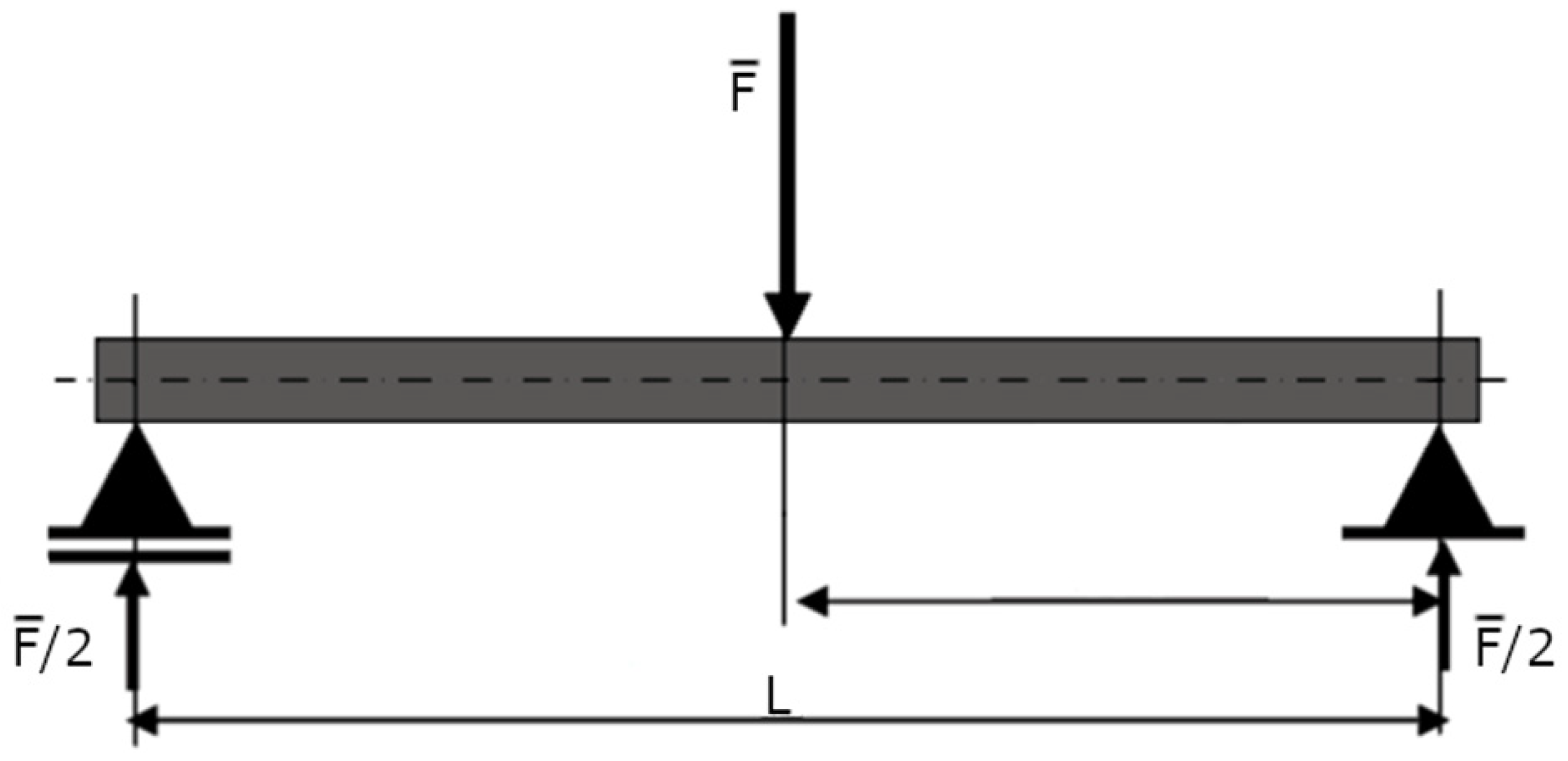
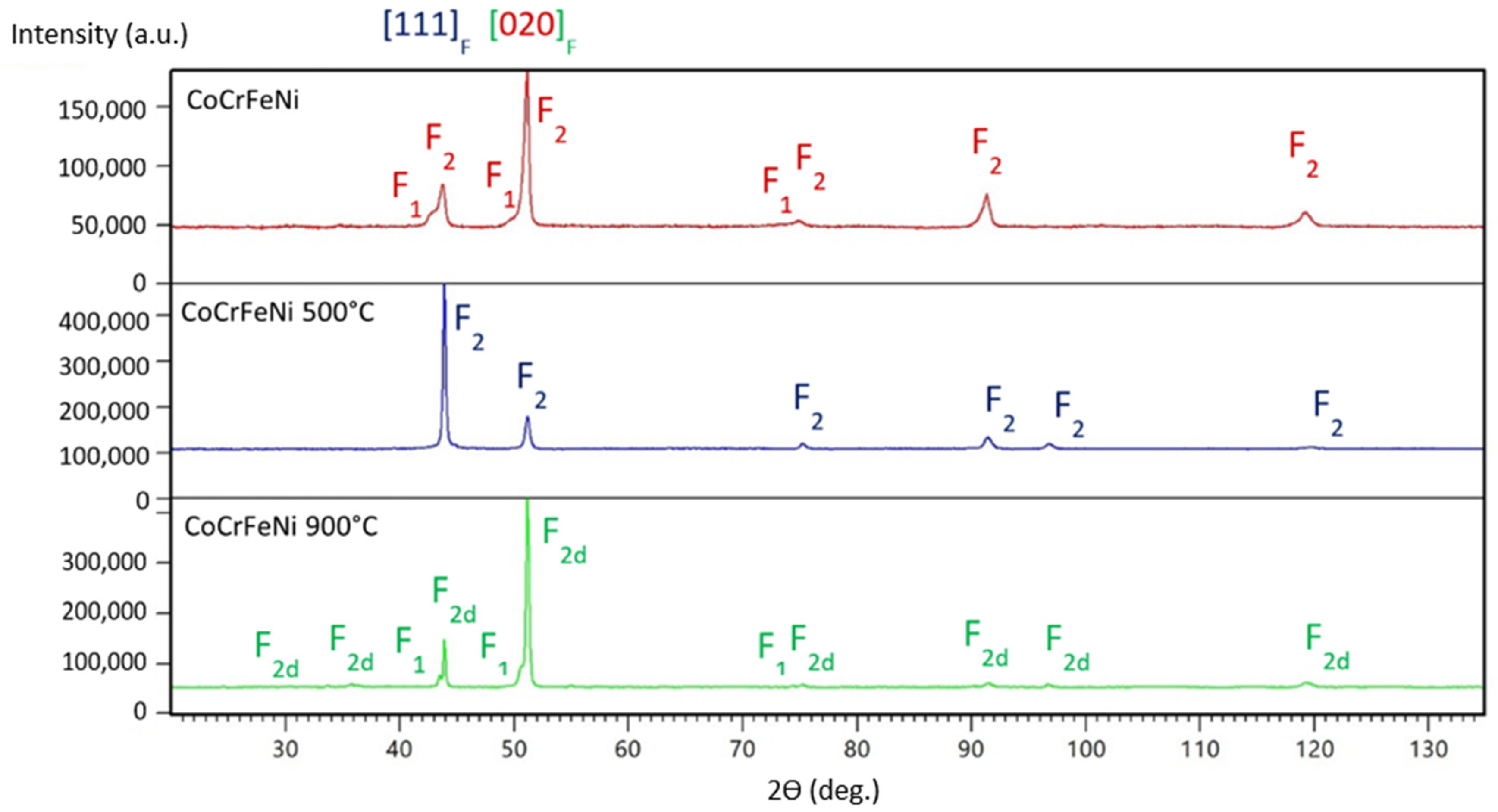
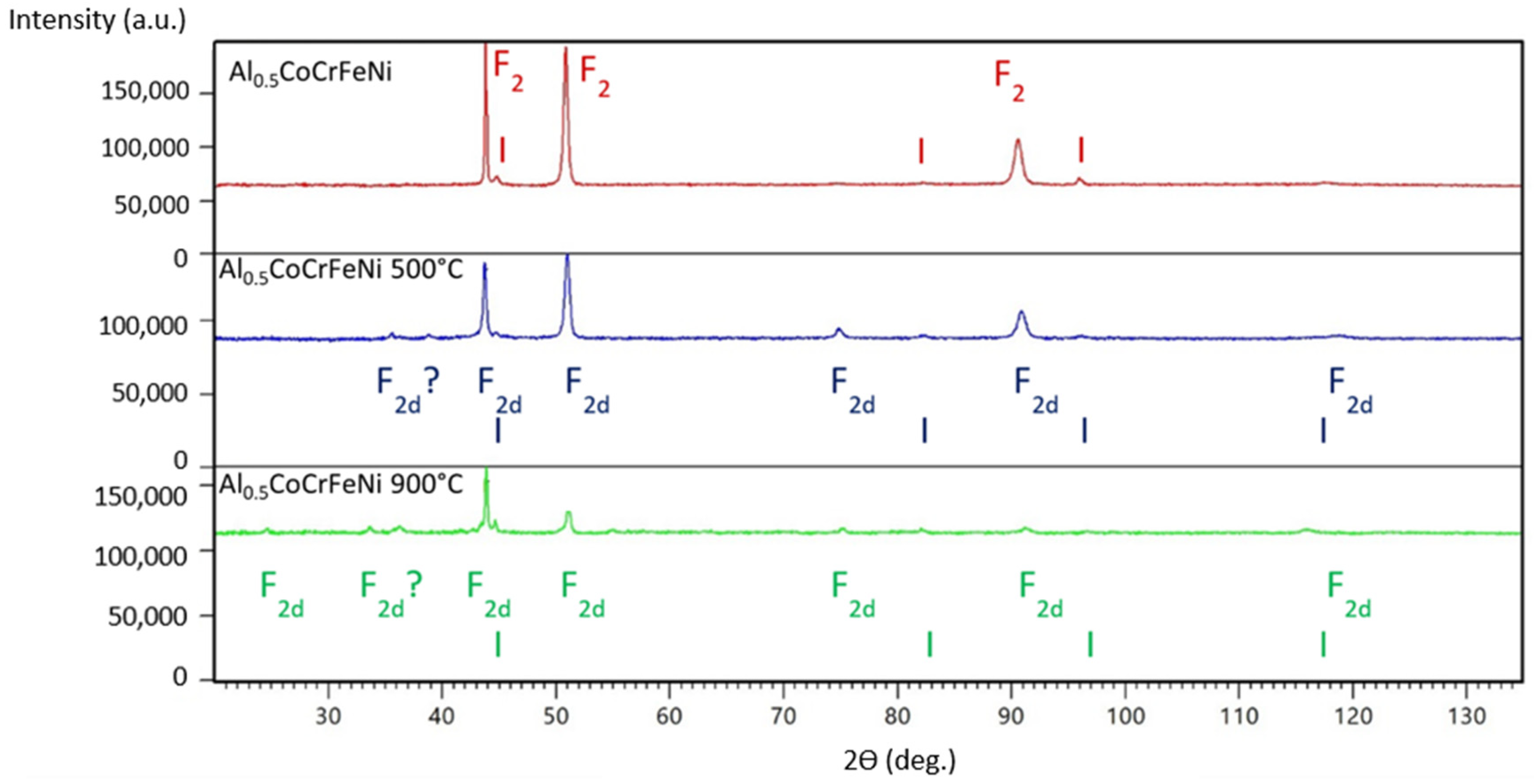
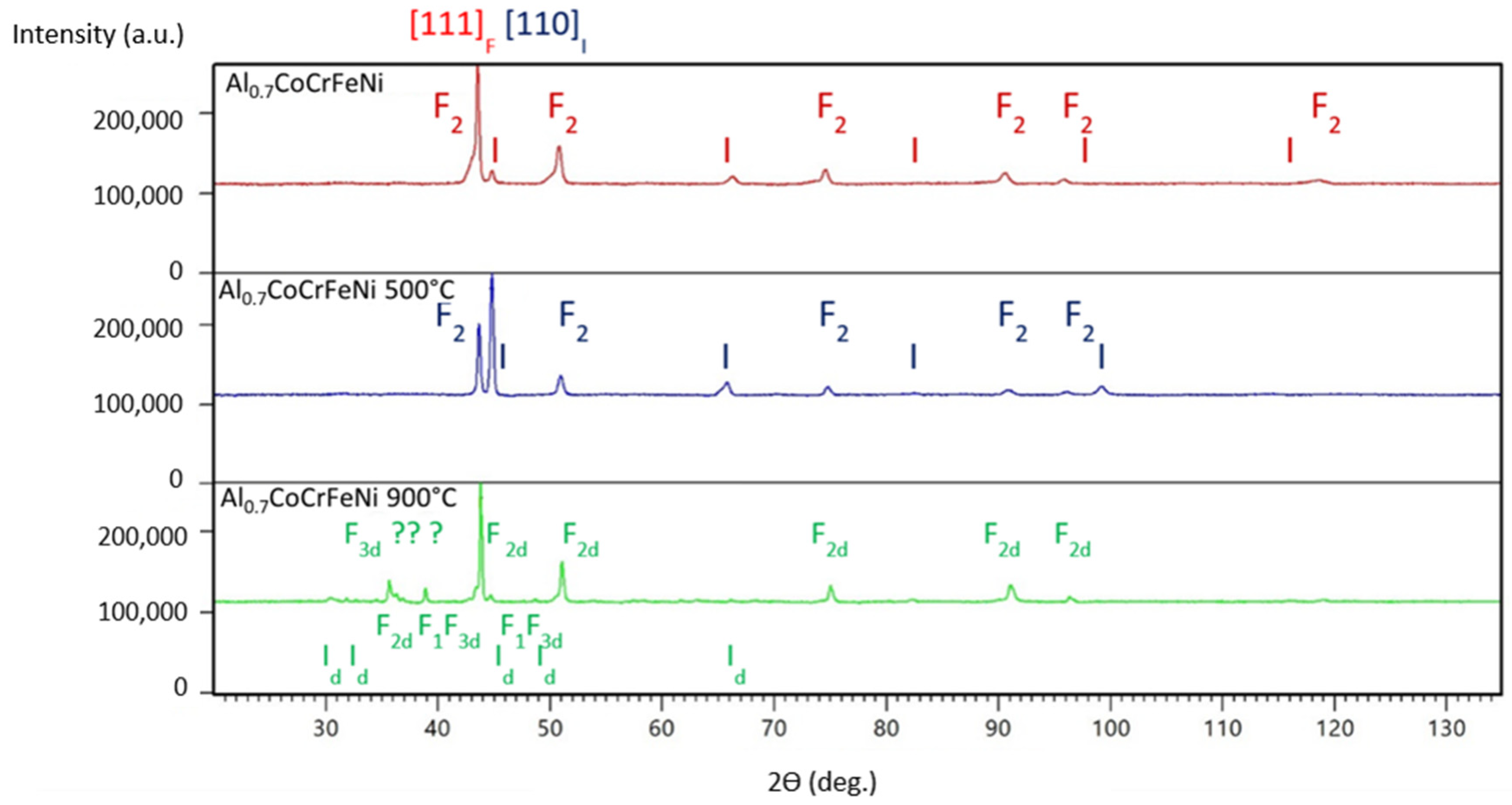

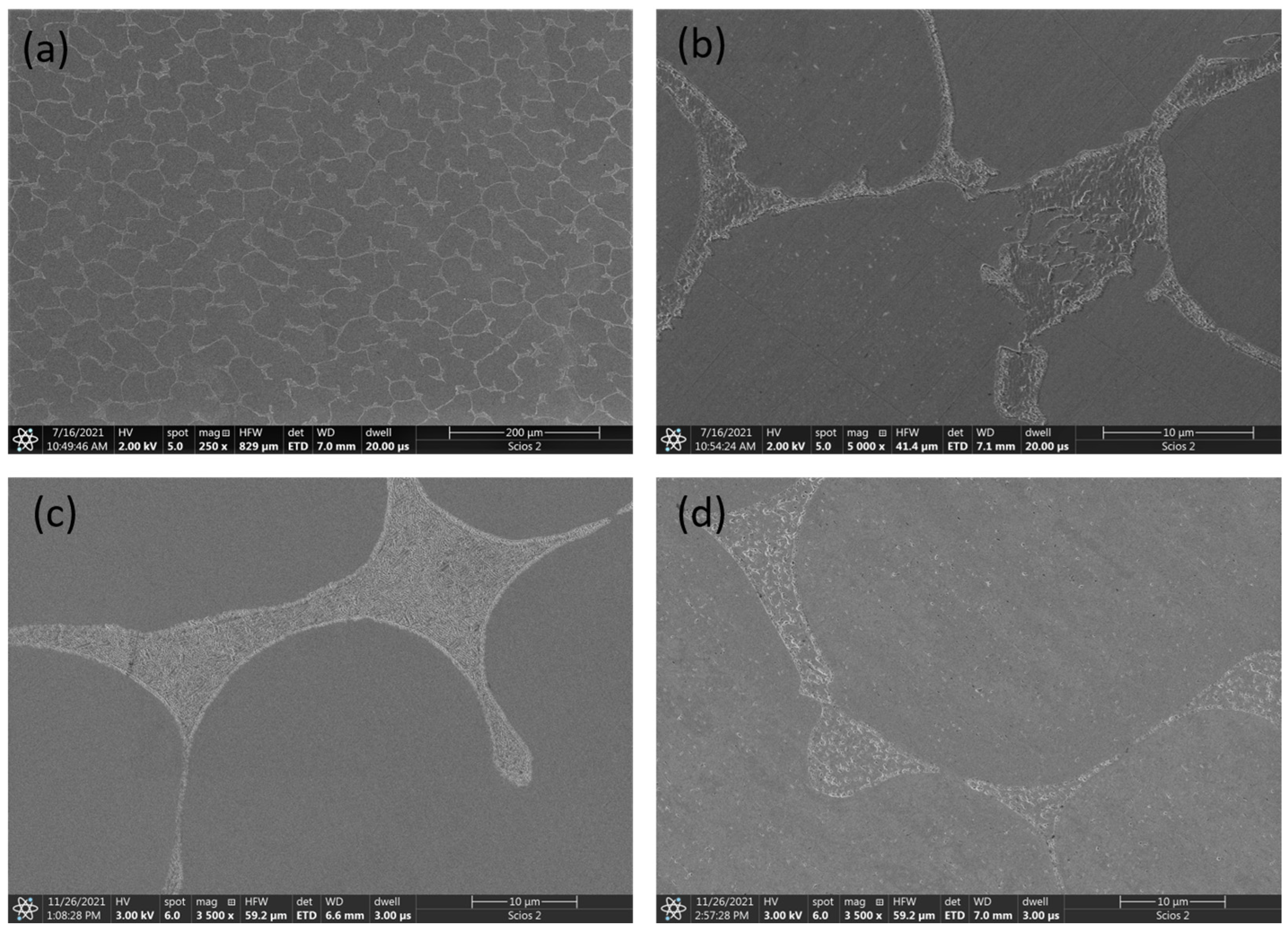
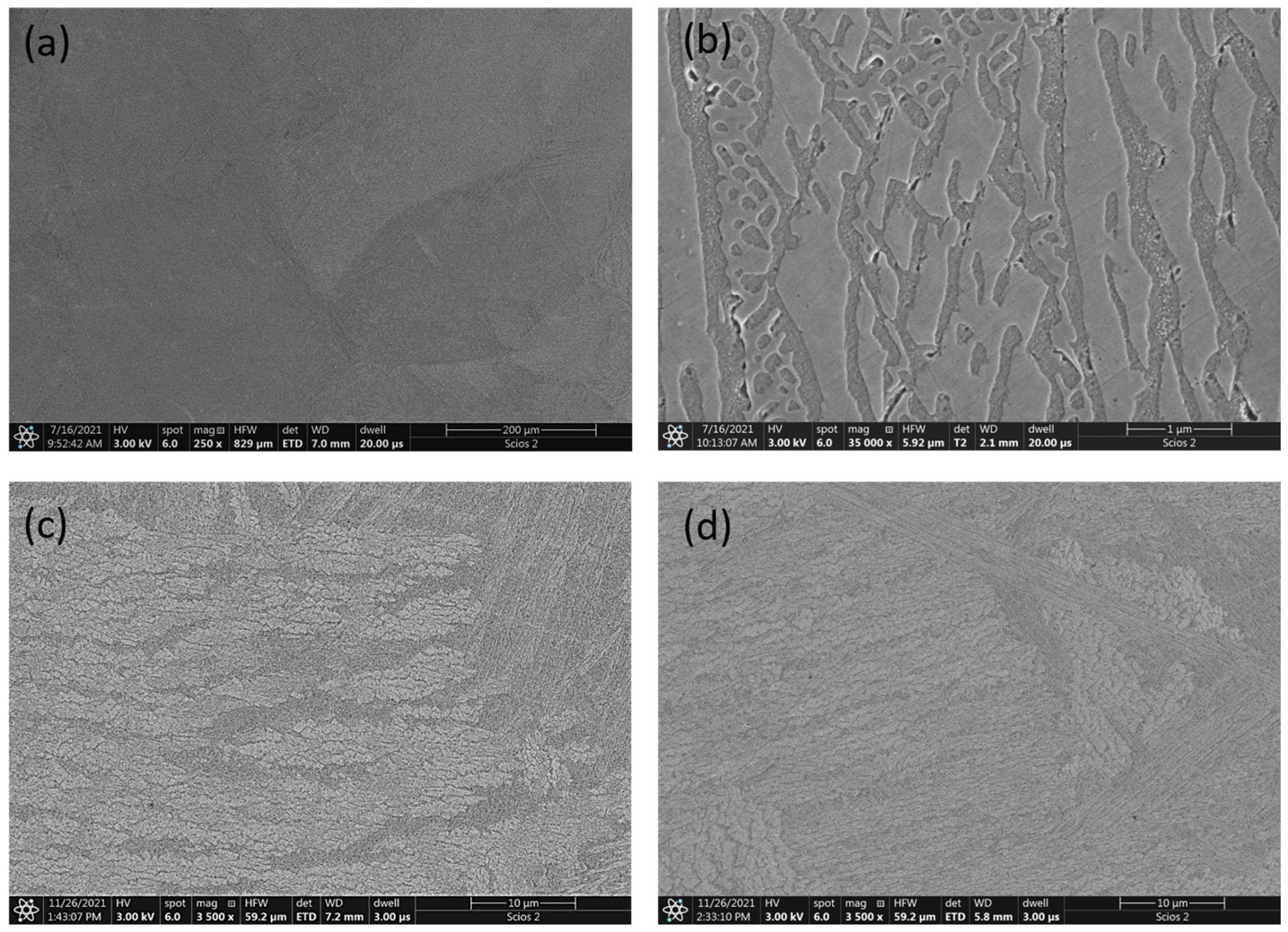
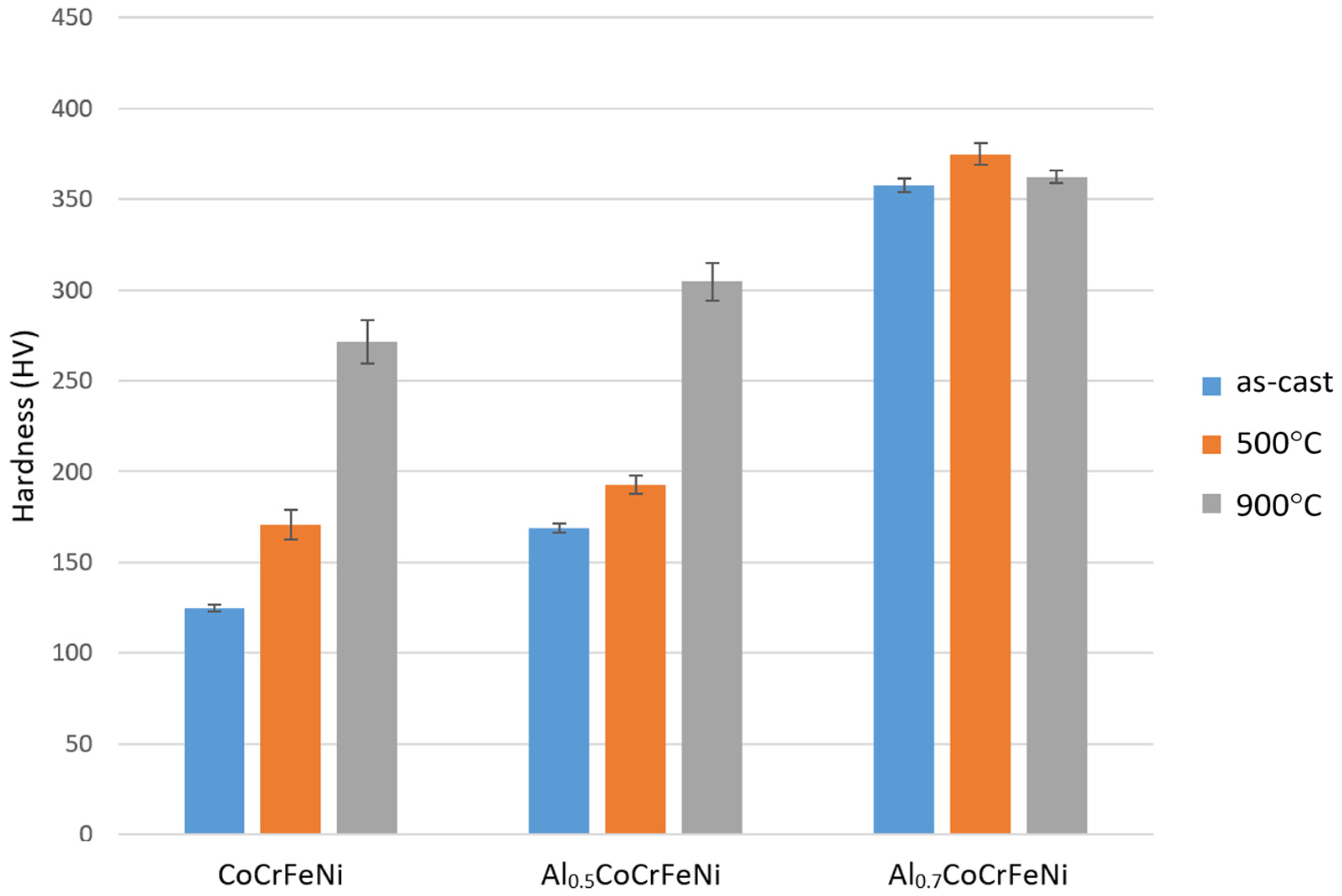
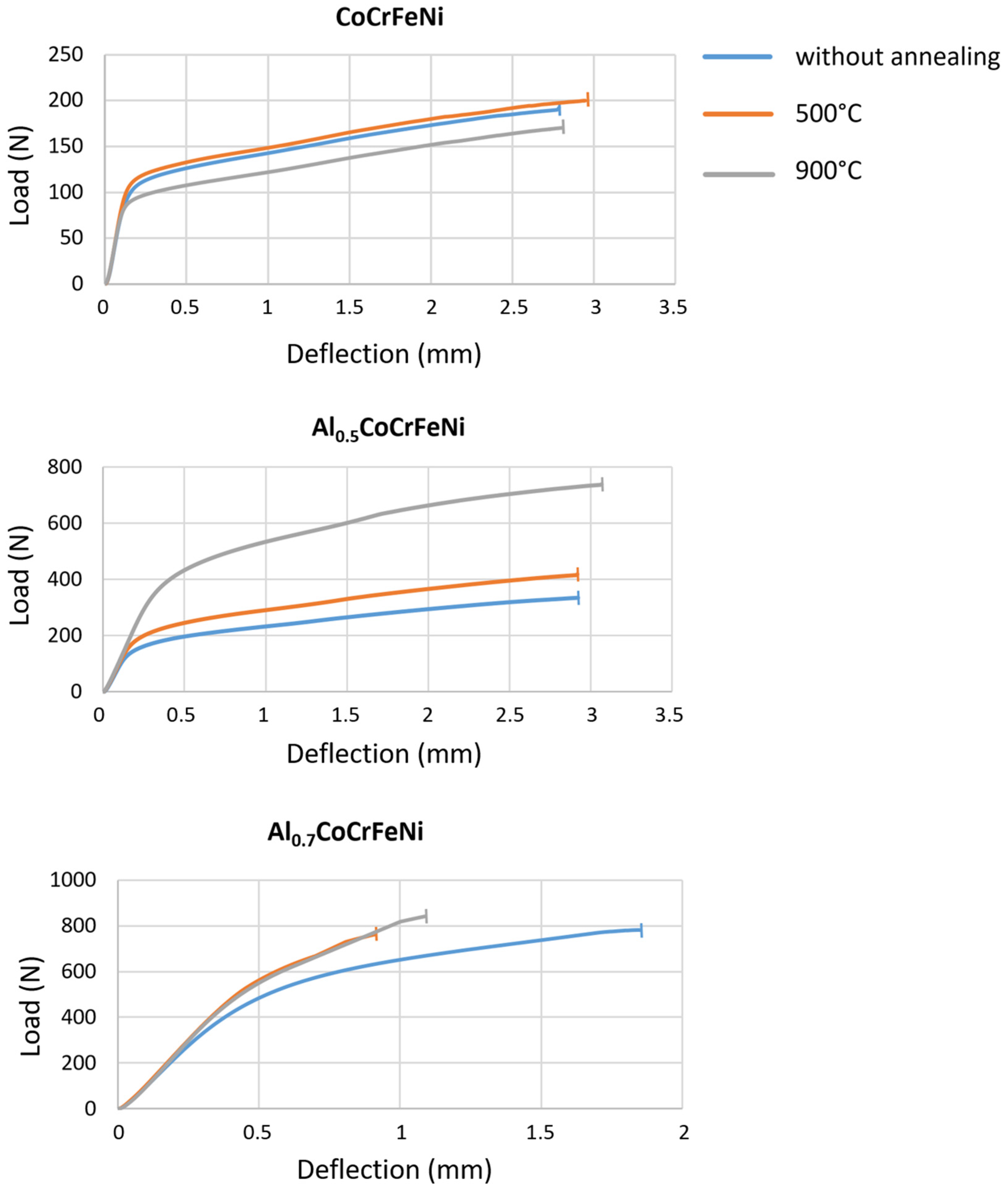


| No Series | Al Content | Alloy | Annealing |
|---|---|---|---|
| 1.0 | x = 0 | CoCrFeNi | as-cast |
| 1.1 | 500 °C | ||
| 1.2 | 900 °C | ||
| 2.0 | x = 0.5 | Al0.5CoCrFeNi | as-cast |
| 2.1 | 500 °C | ||
| 2.2 | 900 °C | ||
| 3.0 | x = 0.7 | Al0.7CoCrFeNi | as-cast |
| 3.1 | 500 °C | ||
| 3.2 | 900 °C |
| Sample | Crystal Structure Data | Vol. % | Graphic Symbol | Crystallite Size (nm) | |
|---|---|---|---|---|---|
| CoCrFeNi | as-cast | 3.6524(3) Å/Fm-3m no. 225 | 19 | ordered fcc/F1 | 3009.7 |
| 3.5644(1) Å/Fm-3m no. 225 | 81 | ordered fcc/F2 | |||
| 500 °C | 3.5768(2) Å/Fm-3m no. 225 | 100 | ordered fcc/F2 | 41.9 | |
| 900 °C | 3.6022(2) Å/Fm-3m no. 225 | 18 | ordered fcc/F1 | 86.3 | |
| 3.5712(1) Å/Pm-3m no. 221 | 82 | disordered fcc/F2d | |||
| Al0.5CoCrFeNi | as-cast | 2.8609(3) Å/Im-3m no. 229 | 9 | ordered bcc/I | 29.8 |
| 3.5915(1) Å/Fm-3m no. 225 | 91 | ordered fcc/F2 | 37.3 | ||
| 500 °C | 2.8637(1) Å/Im-3m no. 229 | 3 | ordered bcc/I | ||
| 3.5796(1) Å/Pm-3m no. 221 | 97 | disordered fcc/F2d | 34.2 | ||
| 900 °C | 2.8642(1) Å/Im-3m no. 229 | 11 | ordered bcc/I | 41.2 | |
| 3.5707(2) Å/Pm-3m no. 221 | 89 | disordered fcc/F2d | 37.2 | ||
| Al0.7CoCrFeNi | as-cast | 2.8584(5) Å/Im-3m no. 229 | 6 | ordered bcc/I | 31.3 |
| 3.5948(1) Å/Fm-3m no. 225 | 94 | ordered fcc/F2 | 51.1 | ||
| 500 °C | 2.8612(2) Å/Im-3m no. 229 | 54 | ordered bcc/I | 33.4 | |
| 3.5926(3) Å/Fm-3m no. 225 | 46 | ordered fcc/F2 | 58.5 | ||
| 900 °C | 3.6578(4) Å/Fm-3m no. 225 | 1 | ordered fcc/F1 | 59.8 | |
| 3.5750(1) Å/Pm-3m no. 221 | 89 | disordered fcc/F2d | |||
| disordered I/Id | 5.7335(8) Å/Fm-3m no. 225 | 3 | ordered L21/L | ||
| 3.6054(3) Å/Pm-3m no. 221 | 7 | disordered fcc/F3d | |||
| Alloys | Area | Element (at. %) | ||||
|---|---|---|---|---|---|---|
| Al | Co | Cr | Fe | Ni | ||
| CoCrFeNi | global | - | 24.82 | 24.50 | 25.59 | 25.09 |
| Al0.5CoCrFeNi | global | 10.96 | 22.72 | 21.27 | 23.01 | 22.04 |
| dendrite | 9.18 | 23.81 | 21.66 | 24.83 | 20.52 | |
| interdendrite | 16.71 | 19.03 | 22.96 | 19.12 | 22.19 | |
| Al0.7CoCrFeNi | global | 13.82 | 21.86 | 21.40 | 22.13 | 20.79 |
| side plate | 10.45 | 22.89 | 22.11 | 23.85 | 20.71 | |
| inter-sideplate | 16.25 | 19.75 | 23.28 | 21.17 | 19.55 | |
Disclaimer/Publisher’s Note: The statements, opinions and data contained in all publications are solely those of the individual author(s) and contributor(s) and not of MDPI and/or the editor(s). MDPI and/or the editor(s) disclaim responsibility for any injury to people or property resulting from any ideas, methods, instructions or products referred to in the content. |
© 2023 by the authors. Licensee MDPI, Basel, Switzerland. This article is an open access article distributed under the terms and conditions of the Creative Commons Attribution (CC BY) license (https://creativecommons.org/licenses/by/4.0/).
Share and Cite
Tokarewicz, M.; Grądzka-Dahlke, M.; Rećko, K.; Łępicka, M. The Influence of Annealing at 500 and 900 °C on the Structure and Mechanical Properties of AlxCoCrFeNi Alloys. Materials 2023, 16, 1245. https://doi.org/10.3390/ma16031245
Tokarewicz M, Grądzka-Dahlke M, Rećko K, Łępicka M. The Influence of Annealing at 500 and 900 °C on the Structure and Mechanical Properties of AlxCoCrFeNi Alloys. Materials. 2023; 16(3):1245. https://doi.org/10.3390/ma16031245
Chicago/Turabian StyleTokarewicz, Marzena, Małgorzata Grądzka-Dahlke, Katarzyna Rećko, and Magdalena Łępicka. 2023. "The Influence of Annealing at 500 and 900 °C on the Structure and Mechanical Properties of AlxCoCrFeNi Alloys" Materials 16, no. 3: 1245. https://doi.org/10.3390/ma16031245








